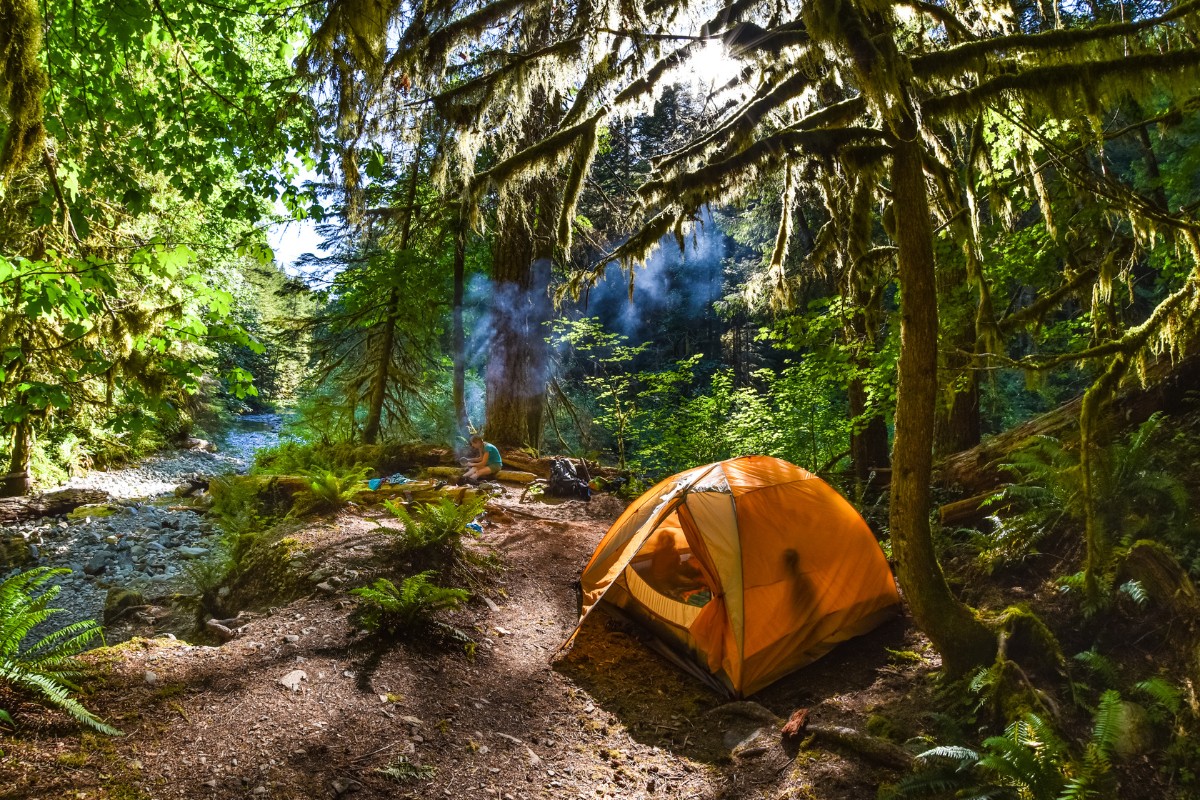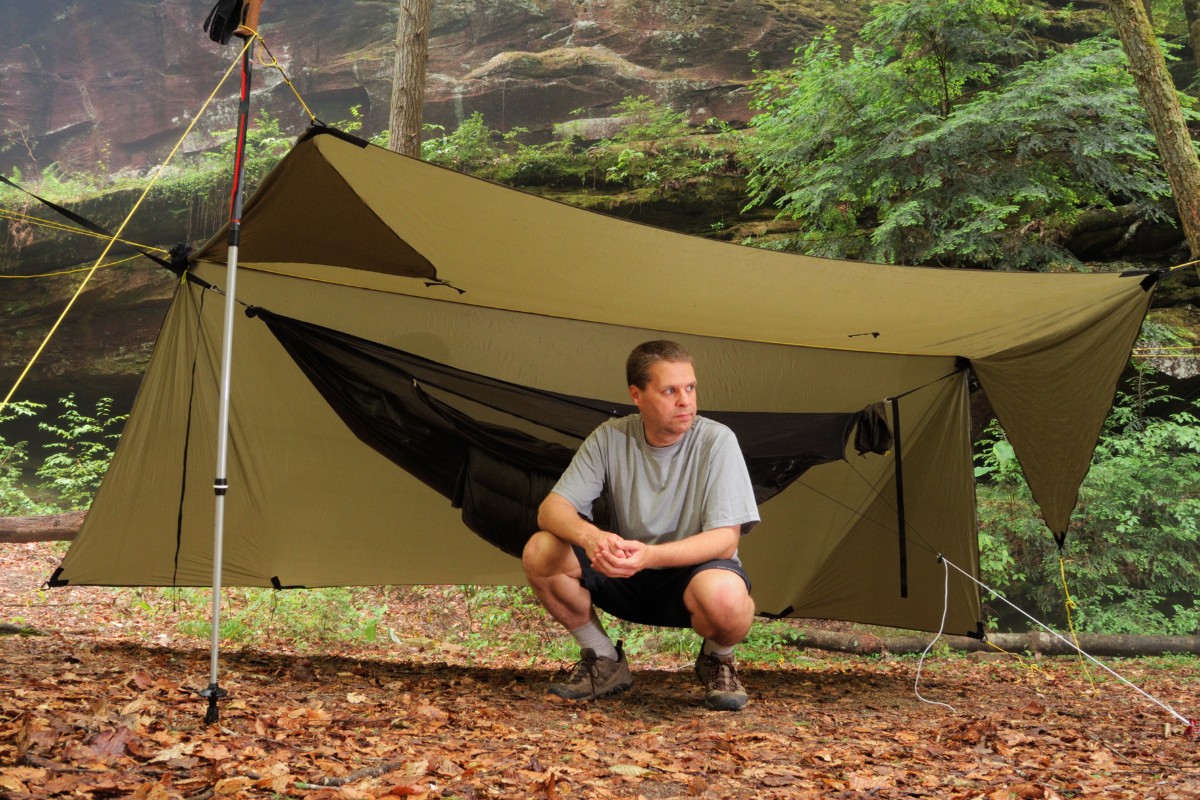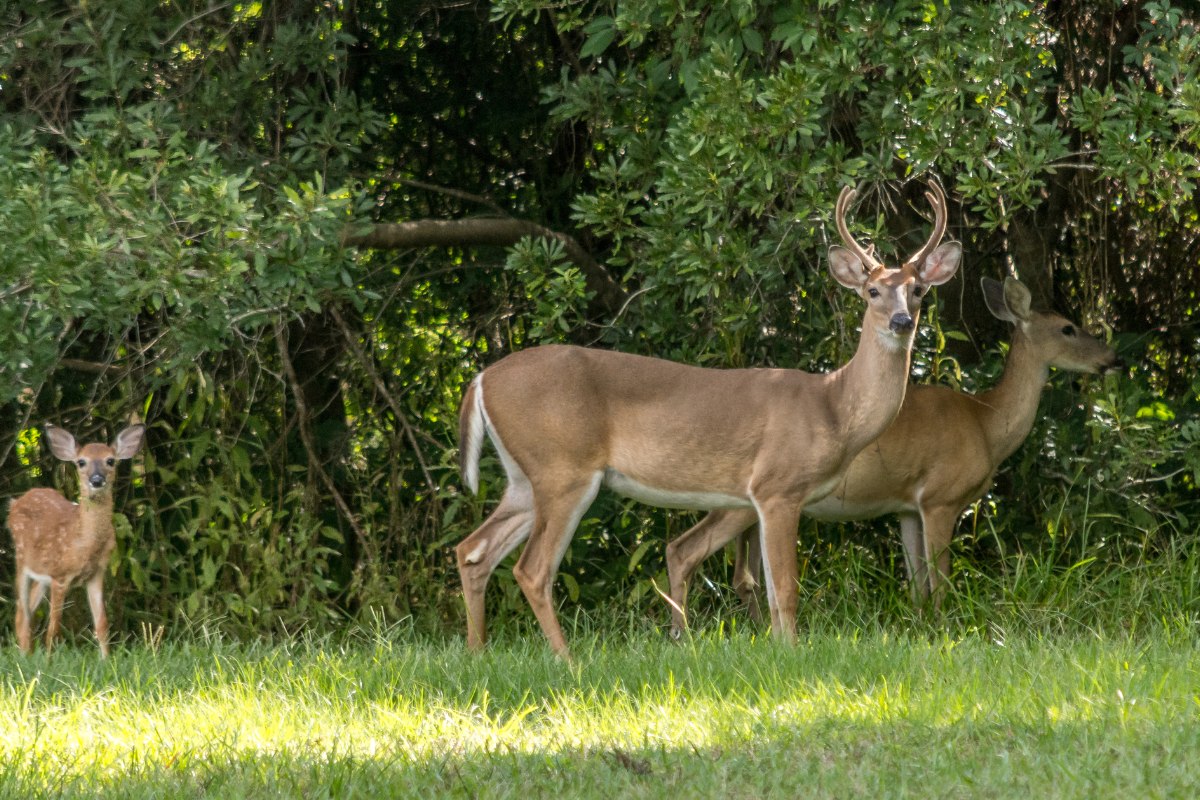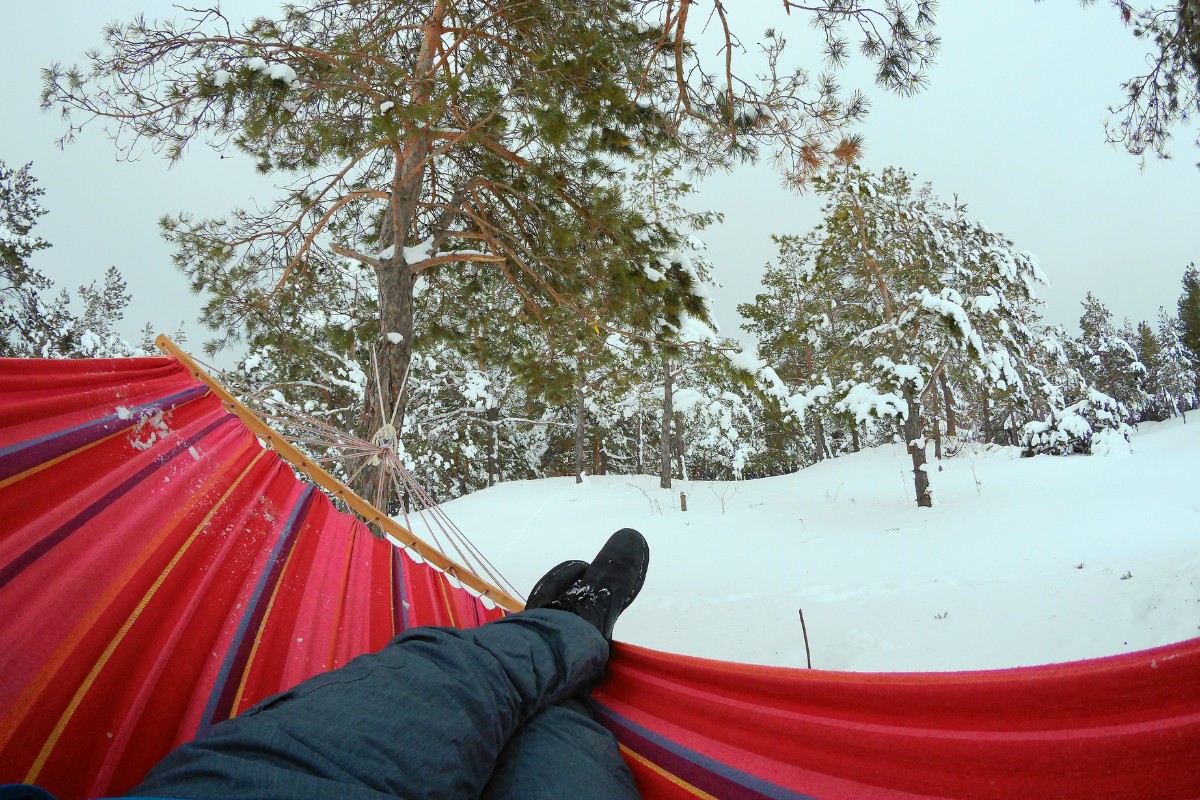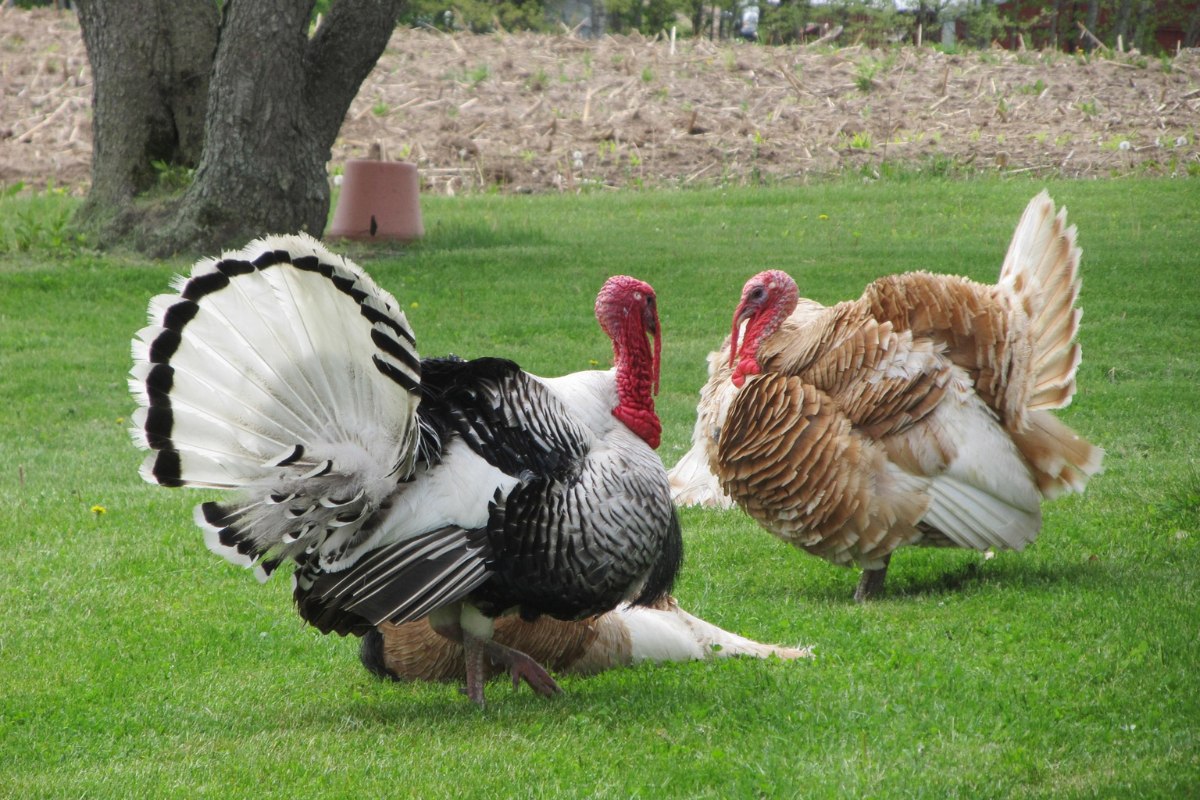Wilderness backpacking, thru-hiking, backcountry camping—these are all just different ways to say you’re going way out there.
Everything you need to set up camp is on your back, and there’s not a developed campsite for miles.
So pick your spot carefully.
This article will go over what to look for and what to avoid in a backcountry campsite. We’ll cover:
- Location
- The elements
- Water considerations
- Respecting the wild
- Knowing the rules
- Safety
A good site can mean the difference between feeling great in the morning and feeling like a zombie who still has to hike home.
Here’s how to scope out a good night’s sleep on the trail:
This Must Be the Place
First thing’s first, are you tent camping?
Or are you sleeping in a hammock tonight?
It’ll make a difference where you set up. For tent camping, good, level ground is important. For hammock camping, it’s finding two good trees.
Tent Spot
In an ideal situation, you’ll find a place where people before you have already camped.
A found spot is the best possible campsite not only because the work of picking a spot is done for you, but you’re also not disturbing a fresh area.
If it’s a well-traveled trail, especially one with designated camping areas, finding a previously used spot might be relatively easy.
It’s easy to tell if a spot has already been used because, well, it’ll look used.
It’s for that exact reason that you’ll want to choose a fresh spot carefully if you end up having to, so your impact on the terrain will be minimized.
Look for a durable place where you won’t be crushing fragile plants.
For obvious reasons, you’ll want a spot that’s relatively flat. If you must choose a spot that has a slight slope, put your head towards the top of the slope.
And finally, before you set up your tent, make sure you’ve cleared the ground of rocks, sticks, and other things that won’t be very comfortable to sleep on.
Hammock Zone
The great thing about hammock camping is, as long as you find two good trees, the ground below can be made out of lava.
(That’s an exaggeration. Please don’t sleep over lava.)
Your impact on the area is minimized since you don’t have to compress the ground where you sleep. Just make sure you’re using tree-friendly straps.
Avoid Low Spots
For both hammock and tent camping, you’ll want to avoid dips and low spots in the ground; that’s where cold air collects in the night.
Sun, Wind, and Rain
If you set your tent up with a clear view to the east, the morning sun will both help you to wake up and dry any condensation that accumulates outside your tent or tarp in the night.
Camping beneath trees will keep you warmer.
The overhang helps heat rising from the ground from escaping. If you’re hammock camping, sleeping under trees is kind of a given.
A breeze through camp is great as a steady breeze can help keep bugs away.
If rain is a possibility, make sure you don’t set up in a low spot. That’s where water will collect, and you don’t want to wake up in a puddle.
Water
Unless you have a very strong back, the only way to go deep into the wilderness is to have access to water.
Setting up camp near a water supply lets you collect water for cooking, washing, and drinking.
To protect waterways and to not disturb the critters who use them, you should stay at least 200 feet away from rivers, creeks, and lakes.
Try to collect as much water as you can in one trip so you don’t have to keep trodding over the same vegetation on your way to the water source.
Leave No Trace
The idea is to leave any area where you camp as wild and undisturbed as when you found it.
When looking for your campsite, work with the nature around you.
Don’t break branches to get access to a spot, and don’t trample fragile plants. When debating between two sites, try to go with the one that offers the least amount of intrusion on your part.
And of course, always pack everything out that you packed in.
Know the Rules
Different parks, forests, and trails have different rules.
Often you’ll need a permit and/or a reservation for overnight wilderness camping.
There are usually limits as to how many people can camp together and how many nights in a row you can camp in the same area.
Some hiking trails have designated areas for camping; other trails prohibit camping altogether. Some areas and trails require you to be a certain number of feet from trails or certain natural features.
Parks and forests put restrictions in place in order to protect the wildlands so everyone can enjoy an uncompromised wilderness.
As you plan your trip, double-check the rules for the time of year and the area you’re headed.
Find out what reservations and permits you’ll need and whether there are any special restrictions.
Plan Ahead
Talk to people who have gone where you’re going, and read trip reports.
Get a map of your planned backpacking area and do a little reconnaissance before you go.
Look for water, high ground, and other natural features that might make a good spot to bed down.
Google Earth is a sweet tool for looking right at the trail you’re taking.
Use it to pre-plan possible campsites and use the coordinates along with your GPS device once you reach the trail.
Of course, you’ll never know until you get out there, but maps and satellite data can give you an idea of the lay of the land to help get you oriented.
Safety
The best spot in the world is useless if something about it is dangerous.
Here are a few considerations to make sure your campsite is safe.
Watch Out for Water
Never camp on a river bank, in a river bed, arroyos (dried river beds), on flood plains, or in narrow canyons or valleys.
If you’re camping in an area where water flows, look for past evidence of floods and high water marks.
You can identify this by the debris washed up on the sides of a waterway.
Always camp above the highest water mark.
Bear Country
Camping in bear country during bear season makes a few differences in how you camp.
Most important is how you store your food.
All food and all toiletries must be kept in a bear-proof container (bear canister) or hung from a tree.
Your bear canister or the tree where you hang your food should be at least 100 yards from where you sleep.
The place where you cook should also be that far from your tent or hammock.
This need for separate, and separated areas means you’ll have to think a little more about situating your campsite in bear country.
Hungry Critters
Bears aren’t the only ones after your food.
Depending on the wildlife situation, you may need to hang your food in bear-free areas too.
Check with the rangers to find out what other animals you may need to consider.
Look Up!
Widowmakers are briefly dead branches hanging in trees that just haven’t fallen yet.
They can come crashing down with awful consequences.
Tent and hammock backpackers should both take a moment to look up and make sure the trees are clear before setting up camp.
You also don’t want to sleep at the foot of a slope or mountainside where rocks or boulders could come loose.
In winter, don’t set up camp or build a fire under trees with snow on them. The cumulative weight of snow is dangerously heavy.
Fire Smarts
Know the fire restrictions where you’re going.
Many wilderness backpacking trails allow camp stoves, but not campfires.
Water Wisdom
Check before you go if there are any water warnings where you’re headed.
Certain contaminants require special filtering/purifying techniques. Don’t get sick from being improperly prepared.
Don’t Let the Sun Go Down on You
While choosing a campsite is relatively easy when you know what to look for, choosing one in the dark is nearly impossible.
As you hike, plan to give yourself time to set up in daylight.
That means stopping about two hours before sunset.
Find the Best Site, and Have a Good Night
With proper planning and an eye for what makes a good site, locating that perfect campsite is part of the excellence of backpacking.
As long as your spot is safe, comfortable, and doesn’t impact the wilderness, you’ll get the most out of wilderness backpacking.
How about you? Do you have a favorite tip for setting up camp?
Let us know!
